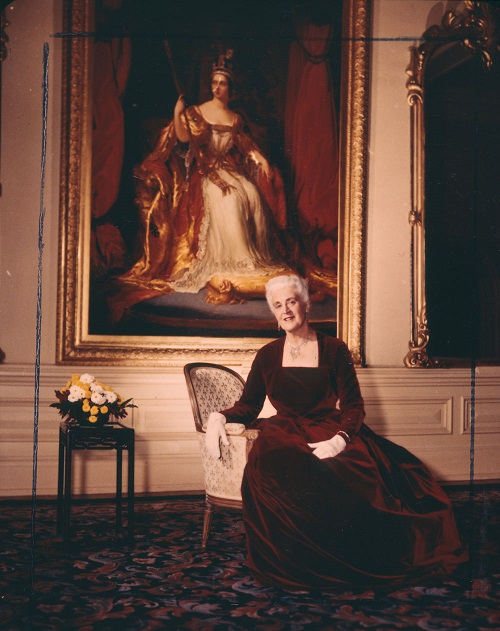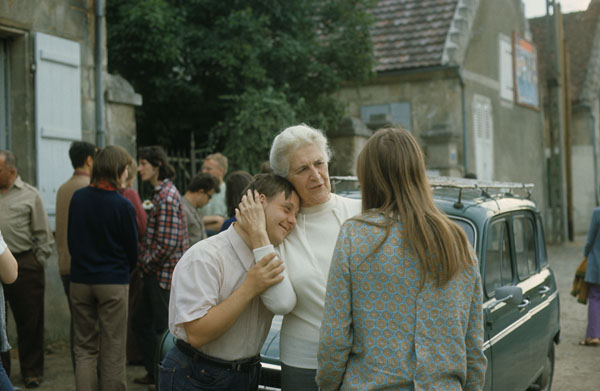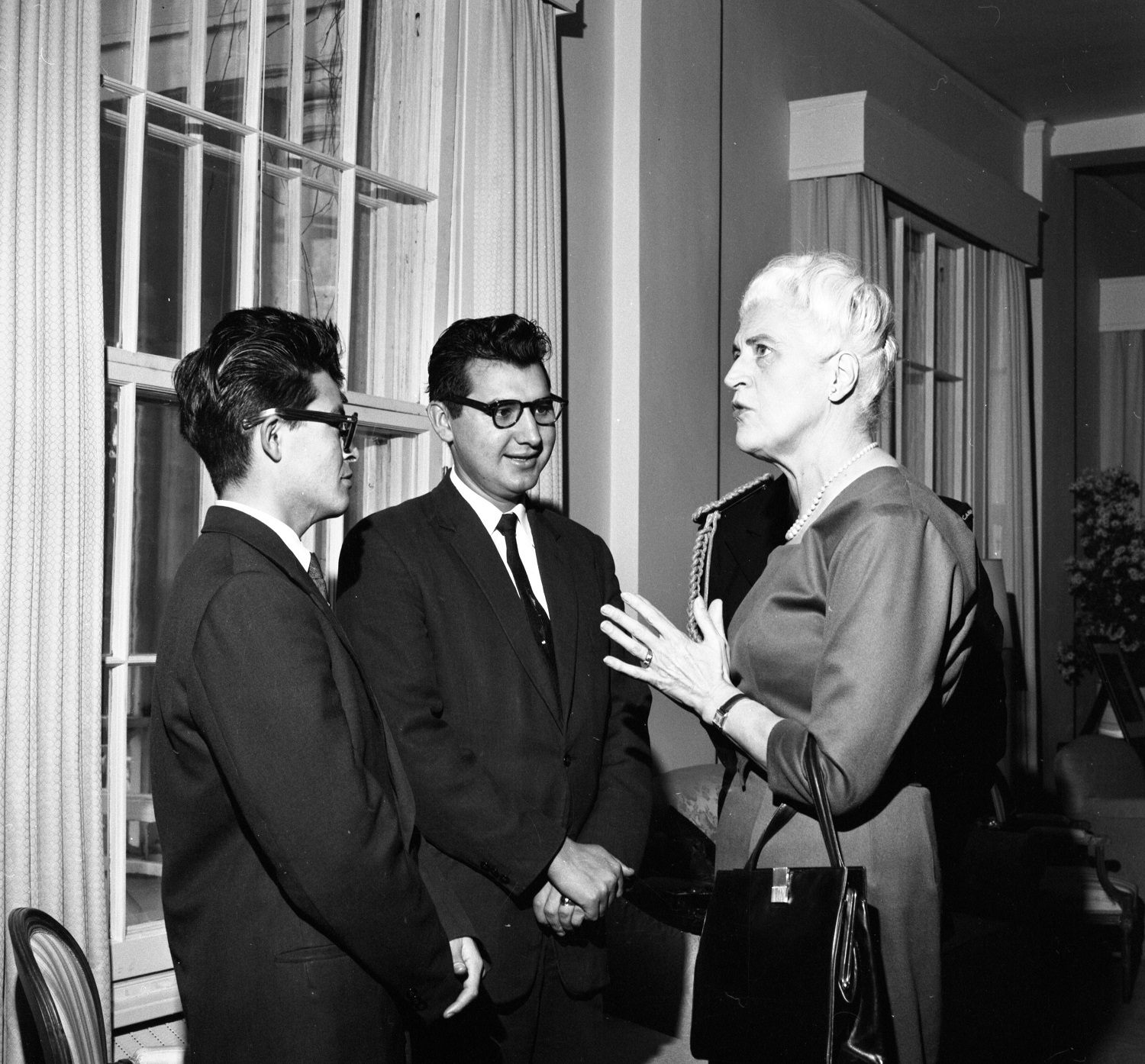
Early Life
Pauline was the only child of Charles Archer, a judge on the Quebec superior court, and Thérèse de Salaberry, a descendent of Charles-Michel d’Irumberry de Salaberry, who commanded the British North American forces at the Battle of Châteauguay during the War of 1812. From the ages of eight to 11, Pauline was educated at the Sacred Heart Convent in Montreal, then at home by governesses who taught French, English, Italian, music and religion. She developed a deep religious faith, recalling later in life, “I seriously thought then I would like to be a nun and was quite attracted to the idea of a religious life. When I was twelve, I heard one of our great missionaries speak about his life in the North, and I decided at once that I would join his order and live in the Arctic.”
Pauline trained as a nurse at the age of 19 and volunteered for the Red Cross at a military convalescent hospital from 1917 to 1919 during the First World War and Spanish flu epidemic. She then joined a committee to welcome returning soldiers to Canada.
Marriage and Family
On 29 September 1921, Pauline married Georges Philias Vanier, a lawyer and founding member of the Royal 22nd Regiment (nicknamed the Van Doos). The couple became the parents of five children: Thérèse, who was a captain the Canadian Women’s Army Corps in the Second World War and then a hematologist and palliative care physician who founded l’Arche communities for people with intellectual disabilities in the United Kingdom; Georges (nicknamed “Byngsie” after his godfather, Governor General Viscount Byng) who joined the Trappist monastery in Oka, Quebec and took the name Benedict; Bernard, a painter and English teacher; Jean, a naval officer, philosopher, philanthropist and original founder of l’Arche community in France; and Michel, a political science professor.

Diplomacy and Humanitarian Work
After their marriage, the Vaniers lived in Kingston, where Georges attended Royal Military College. In 1921, Georges was appointed aide-de-camp to Governor General Viscount Byng, who became a close friend of the Vaniers. Pauline travelled extensively and acted as hostess during her husband’s long diplomatic career. From 1930 to 1939, the couple lived in London, United Kingdom, where Georges Vanier served as secretary to the High Commission of Canada. In 1939, the Vaniers moved to Paris, where Georges served as envoy.

They fled the Nazi invasion in 1940, returning after the liberation of France, when Georges served as Canada’s first ambassador to France until 1953. Pauline was active in aiding refugees displaced by the Second World War, recalling, "We greeted the refugees with drinks, refreshments, clothes and survival kits, and tried to reach their families, friends or anyone who might take them in. Many, however, had no idea whether anyone they knew was still alive, let alone their whereabouts. For them, we arranged temporary shelter. Then we took their photos and stuck these up on long panels lining both sides of the railway station in hopes that someone in the crowds would recognize the name or the picture of a long-lost relative or friend." The Vaniers lobbied for changes to Canadian immigration laws, resulting in 186,000 European refugees settling in Canada between 1947 and 1953.
Vice-Regal Consort
In 1959, Prime Minister John Diefenbaker advised Queen Elizabeth II to appoint Georges Vanier the second Canadian-born governor general after Vincent Massey, who held the position from 1952 to 1959. The appointment was popular with both English and French Canadians because of Vanier’s distinguished military and diplomatic career.
One of the Vaniers’ first guests at Rideau Hall was Princess Alice, Countess of Athlone, who had been viceregal consort from 1940 to 1946. Pauline recalled asking Alice for advice, “So we installed ourselves in my sitting room and [Alice] started. ‘First you must at all times appear slightly aloof and keep a little distance. And never let people call you ‘Pauline.’ You must be prepared for people who will curtsy to you. And on no account must you embrace anyone in public, specially a political figure, lest it show favouritism.’ I found all this very difficult, given my character.”
Pauline supervised renovations of both Rideau Hall and La Citadelle in Quebec City, including the current blue and gold colour scheme of the ballroom at Rideau Hall and a photomural of old Quebec in her dining room at La Citadelle.
The Vaniers hosted numerous distinguished guests at Rideau Hall, including John and Jacqueline Kennedy in 1961 and French president Charles de Gaulle, whom they had supported during the Second World War. Pauline disagreed with de Gaulle regarding Quebec separatism, recalling that in 1967, “General de Gaulle turned to me and said, ‘Madame Vanier, what future do you think there is for Canada?” I replied, ‘General, I can think of no other future than that which my husband envisaged, a country united by two great founding races.’”
The Vaniers travelled extensively in Canada, and the outgoing Pauline was popular with Canadians. Pauline recalled that the cross-country journeys were “the best way to keep in touch with the mood across the country. Nearly always, we received such wonderful receptions wherever we went.”
In 1965, Georges and Pauline founded the Vanier Institute of the Family, following the first Canadian Conference on the Family in 1964. The institute is a national nonprofit organization that promotes awareness and understanding of the complexity and diversity of Canadian families through advocacy, public education, research and publications.
Georges Vanier died in office in 1967. That same year, Prime Minister Lester Pearson appointed Pauline to the Queen’s Privy Council for Canada in place of her husband; governors general customarily joined the Privy Council at the end of their term. Pauline was the first woman outside of party politics to occupy this role.
Chancellor of the University of Ottawa
In 1965, Pauline was appointed chancellor of the University of Ottawa, a position she held until 1973. Pauline was the first layperson and the first woman in this role, and she described her installation as “one of her proudest moments.” In her first speech as chancellor, Pauline alluded to her own deep religious beliefs: “Idealism comes naturally to the young, if we encourage it to flourish. But idealism without a faith to motivate and sustain it will wither when it faces the trials and temptations of adulthood. So above all else, we must cultivate faith and a sense of values in our young or our society will crumble around us.”
Involvement in l’Arche
At the age of 73, Pauline moved to France and became involved in the l’Arche community for people with intellectual disabilities that had been founded by her son Jean in 1964. She was active in the community for 19 years until her death in 1991. Pauline was buried with her husband at La Citadelle.

Honours and Legacy
Pauline was awarded the Légion d’Honneur by the French government for her charitable work. In Canada, Pauline received honorary degrees from numerous universities and was named “Woman of the Year” by the Canadian Press in 1965. On 6 July 1967, Pauline became one of the first Companions of the newly created Order of Canada in honour of her humanitarian work.
There are numerous Canadian schools, buildings and landmarks named for Pauline, including Pauline Vanier Park in Ottawa and Vanier Hall, a women’s residence at St. Thomas University in Fredericton, New Brunswick.
Both Georges and Pauline Vanier have been nominated for beatification in the Roman Catholic Church, one of the steps toward canonization.

 Share on Facebook
Share on Facebook Share on X
Share on X Share by Email
Share by Email Share on Google Classroom
Share on Google Classroom



